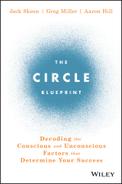Chapter 9
Assessing Your Circle
Figure 9.1 represents how your assessment results would appear if you had fully discovered your power, but had not so completely developed your independence, purpose, and humility. It would also suggest that focusing on humility would be the best place to work on your Circle.
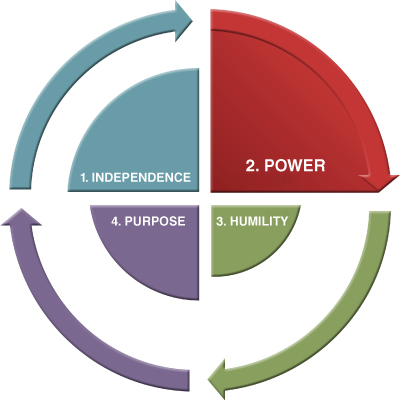
Figure 9.1 An Example of Unbalanced Circle—High Power Driven Circle
A Circle assessment will show which aspects of your Circle are in balance and which are not. It will provide a guide for you to work toward achieving greater balance on your own timetable with complete confidentiality, freedom, and independence. The assessment and exercises are tools that will unlock your greatest possible self by removing whatever is blocking you from achieving all that your life was intended to be.
Once you have completed the overview, you may wish to take an online assessment that will allow you to gauge the balance of your unique Circle. This process will help you interact with the book and discover opportunities for personal growth.
The assessment is a reliable instrument based on scientifically validated theory that will identify the core issues that are holding you back from having the happy and successful life you seek. We know too many people who spend thousands of hours in and dollars on therapy in the hope of understanding these issues. Having a reliable instrument that can provide this information (think of this like a good bathroom scale for your weight) will make it much easier for you to focus on desired areas where you may be lacking balance. Unlocking these issues is the first step toward being able to pursue your personal goals and dreams. Alternatively, as you read through the book, note those areas that are important to you and focus on the steps provided at the end of each chapter. Refer back to these areas as you continue on your path.
Either way, the assessment or simple self‐reflection as you work through this book will empower you to take ownership of your life and to provide you the tools to make whatever improvements you want to make on your own timetable.
The assessment first provides you with an overall measure of your mastery of each of the four key elements shown in Figure 9.1. The overview will give you a high‐level picture of where you are strong and where you may have work to do. You will learn whether you have mastered one or more of the four key development elements and which ones might require your attention.
Each element of the Circle Blueprint is broken into five or six discrete factors and subfactors. These factors and subfactors provide more detailed information about specific developmental areas of mastery or those that need work.
We all have enduring personality traits that are the result of the mix between our inherited genetics and how we were nurtured. Some of us are outgoing and gregarious, while others are shy and reserved. Some are optimists, always seeing potential positive outcomes, while others are pessimists, seeing what might go wrong. Some are detail‐oriented and so make good accountants and doctors. Others are generalists and so are well equipped to see the big picture of where an opportunity might be seized. There are no good or bad personality traits. The combination of our personality traits is what makes each of us unique. And it is this unique combination of personality traits that creates our dispositional tendencies or how we tend to behave in every situation in life.
Some of our dispositional tendencies are called a “manifest quality,” which simply means that they can be clearly seen by ourselves and by others. For example, if you are a reserved person, it is highly likely that you and your friends know this about you. Many of our dispositional tendencies are manifest qualities.
Our latent tendencies, on the other hand, are not so obvious. These are our dispositional tendencies that are subconscious or unconscious. Hence, they are not in our awareness and are most often hidden even from those who know us well. Perhaps you have an insecurity about not being recognized for your uniqueness. If so, it might not be something of which you are aware. You may have compensated for this insecurity by not seeking recognition and, in the process, limited your ambition. Or, you might have been bullied as a child and now instinctively respond with anger to those who have authority and power. You might be aware of getting angry around certain people, but be completely unaware of why you do so. It is often our latent tendencies that most interfere with our ability to complete a balanced Circle. It is as if our latent tendencies control us more than we control them. And, because they are difficult for us to see, it is almost impossible for us to develop effective strategies to deal with them.
The Circle Blueprint assessment was designed to measure latent personality attributes for the purpose of translating them into manifest factors for each element of the Circle Blueprint. You may also gain appreciation of these attributes without the assessment if that is more comfortable with you. Either process brings visibility to the underlying causes so that you may introduce an intervention and produce positive change.
The following are examples of why the assessment or self‐reflection are necessary to determine an individual's latent dispositional traits as behavioral drivers.
Example 1: Independence and Power‐Driven with Low Humility and Purpose
Let's say you are in a meeting with several other colleagues and the meeting is of little or no value for you, and you are providing nothing in return to the other members of the meeting. You decide to get up and leave the meeting before its conclusion. Your Circle most likely reflects either Figure 9.2 or Figure 9.3.
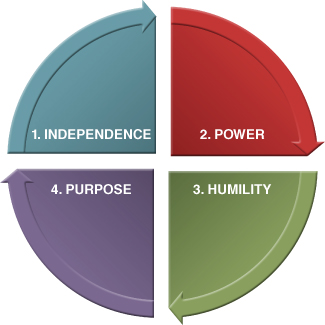
Figure 9.2 Balanced Circle
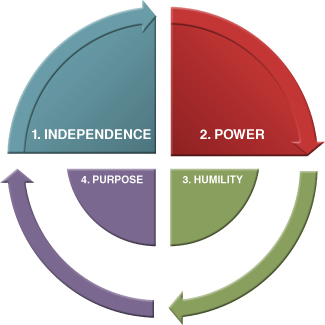
Figure 9.3 High Power and Independence‐Driven Circle
If the assessment were to reveal that you have a balanced Circle:
- Your actions would be driven by your need to be useful elsewhere.
- The others in the meeting would perceive your actions to be reasonable, and your goal for leaving the meeting would have been to achieve some greater good elsewhere in the organization.
- You would perceive the group you left not as having been a waste of your time or theirs.
- You simply would have felt that a greater good could be achieved by all as a result of your absence.
If, on the other hand, your Circle was imbalanced and driven by independence and power:
- You would probably be perceived as being insensitive and overbearing.
- You would have left the meeting because you judged it to be a waste of your time.
- Your main goal would have been to demonstrate your power rather than to serve a greater good.
Often your action itself is less of an issue than the driver of your action. Many people have trained themselves to outwardly reflect prosocial behaviors so that others perceive them to be positive, powerful, or sincere. Yet, they are out of balance and their imbalance shows up in ways that are far less than optimal for themselves and for others.
The assessment or deep self‐reflection on the issues as you go through the book gets to the core of the latent drivers of your behavior and can you help unlock your potential as your personal awareness of those drivers is increased.
Example 2: Power and Purpose‐Driven with Low Independence and Humility
On Ash Wednesday, an executive (who proclaims herself to be a Christian) ensures that she stops at church prior to arriving at work so that she spends the entire day showing everyone the ashes on her forehead.
Her Circle Blueprint most likely reflects either of the following:

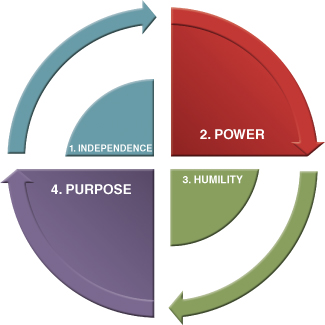
If the assessment were to reveal that she had a balanced Circle:
- Her actions would be driven by the simple desire to display her faith to all whom she encounters.
- The people she encounters throughout the day would perceive her actions to be truthful and sincere.
- She would have no judgments toward those in the organization who are not displaying ashes.
- With balanced independence she would have no concern for those with whom her religious display creates affinity or for those who might be put off by it.
If, on the other hand her Circle was imbalanced and this person was lacking independence and humility:
- This act would be driven by the need to be accepted by others (perhaps a Catholic boss).
- Her actions could be an attempt to show moral authority (low independence and humility).
- She would be perceived by the organization in an unflattering way, perhaps as having an overly pious or judgmental attitude.
Examples such as these can sometimes spark strong reactions. That is why we include it. You might ask yourself what is more important, the outward sign (ashes) or the inward intention? If you believe the inward intention establishes the value of the outward sign you understand why becoming clear about our intentions is so critically important. It is possible that neither she nor the people who see her truly understand the reason she is displaying the ashes. But, her true intention is having an impact, either positive or negative. It is either a display of her balance, in which case her sincerity of heart will shine, or it is a hidden effort at manipulating how she is viewed, which will ultimately lead to nowhere.
An appropriate and reliable assessment or sound self‐reflection can unlock the latent drivers of your behavior. What is especially noteworthy is that often people are completely unaware of their imbalance and are acting on patterned behaviors that are creating misery in their lives and in the lives of those around them. It is important to note that we are not passing judgment. We simply see these imbalances as traps that take you off the path of thriving and reduce your chance to unlock your potential and greatness.
Example 3: High Independence and Purpose, Combined with Low Humility and Power
Bill is an artist. He sees himself as having a higher calling than most people and intends to live his life true to that calling. Hence, he spends all of his time painting. He hasn't yet sold a piece for more than a few dollars. Even though he is 30 years old, he certainly can't support himself and so he lives with his parents and has the very same bedroom he had as a child. In fact, his parents continue to provide him with most of the essentials he needs to maintain his life. He eats at their table and, when he needs transportation, drives their car.
Bill's Circle Blueprint most likely reflects either Figure 9.6 or Figure 9.7.
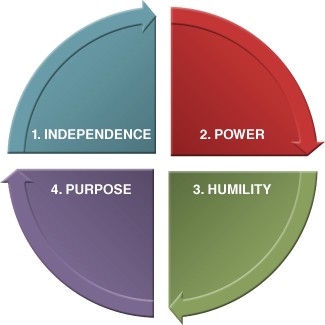
Figure 9.6 Balanced Circle
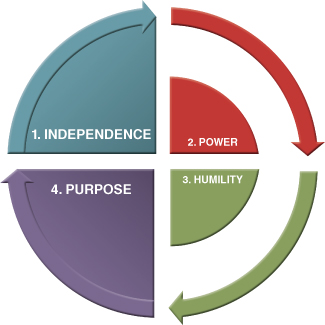
Figure 9.7 High Independence and Purpose‐Driven Circle
If Bill's Circle is truly balanced:
- He would have accurately assessed that he has unusual talent as an artist.
- His commitment to his craft would be sacrificial on his part, an investment in his calling that one day would prove itself with success and notoriety.
- Bill would regret being a burden on his folks and would do everything within his power to minimize that burden, including getting a job to support himself.
If, on the other hand, his Circle Blueprint assessment indicated he had not yet fully cultivated his power and humility:
- Bill's assessment of himself as a talented artist would likely be more of a wish than a reality.
- He would be either unaware of his imposition on his parents or insensitive to it. It is likely he would feel entitled to their support because he believes himself to be so special.
- Bill may be inclined to foster the fantasy of his talent despite persistent evidence to the contrary. Rather than becoming more useful in the world around him, he could become progressively more irrelevant.
Perhaps you know someone like Bill. It may be a chronically underemployed husband who believes he deserves a much better job but won't do what it takes to obtain it. Or the dreamer who thinks she is a talented musician and dominates her church choir even though she can't carry a tune. People such as these have not yet discovered their power, and yet have somehow created a social system that enables them to live with the appearance of autonomy and independence even though they have no real independence or autonomy at all.
Parents can foster this unhealthy pattern in their children when they take on excessive responsibility for their children's welfare. It is certainly necessary for parents to provide necessities for their children including food, shelter, clothing, instruction, correction, advice, and guidance. But, when parents feel obligated to provide designer clothes, state‐of‐the‐art electronics, the best private schools, world travel, and a college and graduate school education, the effort to prepare children for the future can backfire. Such excessive provision may actually undermine their children's independence and their successful quest to discover their unique power and place in the world. Instead of creating a solid base for success, parents can unintentionally foster their children's attachment to inflated fantasies of their giftedness and unrealistic expectations about life.
Sir Richard Branson is someone whose parents knew not to make that mistake. He tells this story of his early childhood:
There is a rather well‐known story about Mum stopping the car on the way home from a shopping trip and telling me to find my own way home—about three miles through the countryside, and I was somewhere around five years old. She was punishing me for causing mischief in the back seat, but she was also teaching me a larger lesson about overcoming my disabling shyness and learning to ask others for directions.
When hours had past, the sun was setting and Richard had not yet arrived home, his parents went looking for him. He had made friends with a farmer and was happily riding with him on his tractor. (Preston 2013)
While it might seem irresponsible to leave a five‐year‐old child on the road alone, such challenges became opportunities for Branson to cultivate his resources. He learned to take responsibility for himself, to think creatively, to engage others when needed, and to master his fears. Many of the skills that he learned early in life equipped him well to go on to be a world adventurer and wildly successful businessman.
Because it is so natural for parents to want to provide and protect their children, they often get in the way of the critical life lessons that are necessary to gain independence, find power, learn humility, and discover purpose. Unfortunately, these parental miscalculations can leave their children with distortions in their Circles that undermine the quality and impact of their lives.
Example 4: Power and Purpose‐Driven, with Low Independence and Humility
Your father‐in‐law has a good job and some level of financial security. He decides that it would be a great idea to take the entire family (meaning your husband/wife, kids, brothers‐ and sisters‐in‐law, etc.) on a vacation cruise during the Christmas holidays. This would require that you spend the only vacation time remaining for the year on this trip with your extended family. You're also not overly excited about spending the entire holiday with your spouse's siblings and their spouses.
Your father‐in‐law announces the trip and tells everyone the tickets have been ordered. Your father‐in‐law's Circle Blueprint most likely reflects either Figure 9.8 or 9.9.
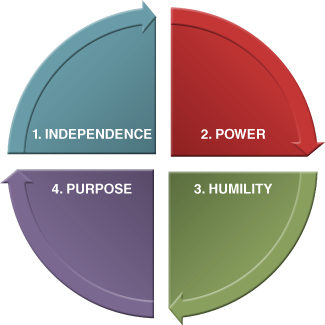
Figure 9.8 Balanced Circle

Figure 9.9 High Power and Purpose‐Driven Circle
If the assessment were to reveal that your father‐in‐law had a balanced Circle:
- His actions would be driven by his desire to provide for his family.
- The family would likely perceive his actions to be well intended and the gesture to be heartfelt and genuine.
- He would see the gesture as simply trying to be nice and do something for others he loves rather than as an exertion of his power or showing off his wealth.
If, on the other hand his Circle was imbalanced and driven by power and purpose:
- He may have been driven by his belief that he knows what is best for everyone regardless of what they say.
- He may think that you are not taking this type of vacation because you cannot afford to do so, thus he considers himself to be very giving.
- His main goal would be to demonstrate control and power rather than to provide a relaxing trip for the family.
The lack of independence in this imbalanced Circle expresses itself through his inability to know what makes him happy that presses him to piggyback on the fun he wants to make happen for others. The lack of humility in this profile would show up in his blindness to the true wishes of others and his insensitivity to the very idea that not everyone might want to spend their precious holiday and vacation time with dear old Dad. If he is out of balance, the result will be a vacation filled with tension, frustration, and resentment that will catch him by surprise as he fails to understand the drivers of his actions.
Example 5: Power, Humility, and Purpose‐Driven, with Low Independence
This example is very common and demonstrates the importance of having mastered independence before life can flourish.
A very powerful and wealthy man has taken the day off work to hang out with some friends. He lives in an affluent neighborhood in a large home. When his friends arrive at his house the man greets them at the door wearing only his dress shirt, boxer shorts, and dress socks—no pants. He invites his visitors into the kitchen. When they arrive they find several pairs of dress shoes strewn over the counter. The man begins the conversation with his visitors as he continues shining his shoes.
The visitors finally ask the man why he is standing in his boxer shorts in his kitchen polishing his shoes? He laughs and responds that his wife is out of town. The men are puzzled. The wealthy man explains that his wife doesn't allow him to walk around the house in his boxer shorts and he is not allowed to shine his shoes in the kitchen.
The wealthy man's Circle Blueprint most likely reflects either of the following:
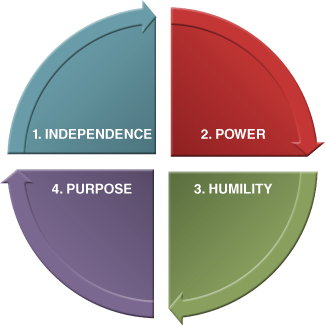
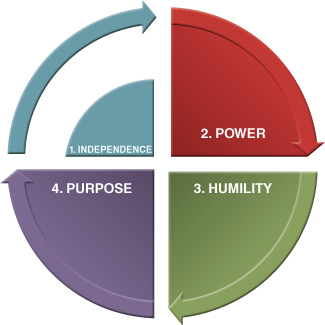
If the assessment were to reveal the wealthy man had a balanced Circle:
- His actions would be driven by his desire to engage in actions that are not pleasing to his wife but in a respectful way. He waits until she's out of town so he can relax, but there is no sense of having an “I'll show her who's boss” attitude.
If, on the other hand his Circle was imbalanced and driven by his lack of independence:
- He may have been driven by his desire to engage in any behavior displeasing to his wife while she's away.
- His main goal would have been to demonstrate that he can and will do whatever he wants, even if he has to do it behind her back. He feels a sense of control while she's away.
The good news is that you can get on track and make progress toward your goals by balancing your Circle. It doesn't matter where or when you start in balancing your Circle in order to find true fulfillment. What is important is that you start on the life‐changing process that can advance you from a life of mere survival to a rich life in which you can thrive and prosper.
The Assessment Process
- You will begin by assessing your activities; what's in your Circle? This will help you see how you spend your time and how you feel about the choices you've made as you've prioritized your life.
- As you work your way through each chapter, you will better understand each key element of your Circle Blueprint. At the end of each chapter you will be invited to complete the core assessment for that element or to reflect on this issue yourself. The assessment we provide will show you the results as you complete each chapter and compare the results with the preassessment. We will provide you with your detailed Circle Blueprint assessment. You may wish to do this through self‐reflection instead. Either way, you will have clarity about the areas where you need better balance and the specific factors of each element where you need the most work. This map will guide your development.
The immediate feedback assessment methodology enables you to gain insight into your growth through the interaction with the concepts that we presented. As you experience the power of growing and developing awareness, you will learn that you have the power to make real and constructive change in your life. This power emancipates you from whatever has been diminishing your spirit. As you balance and expand your Circle you will see that you have within you everything you need to thrive.
To begin your assessment process, please go to www.thecircleblueprint.com to create your logon. Your assessment is confidential. You will be the only one who sees your results. Once you log in you will be invited to begin the assessment. Alternately, if you are not interested in the actual assessment, substitute honest self‐reflection as we go.
